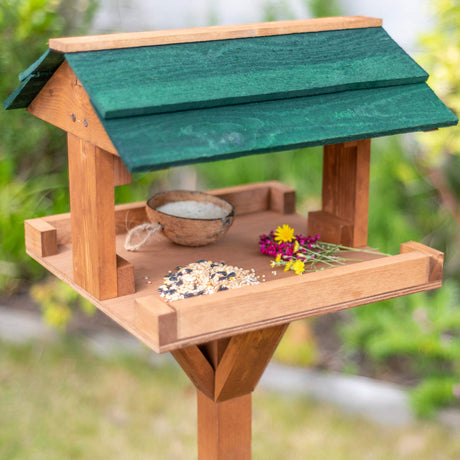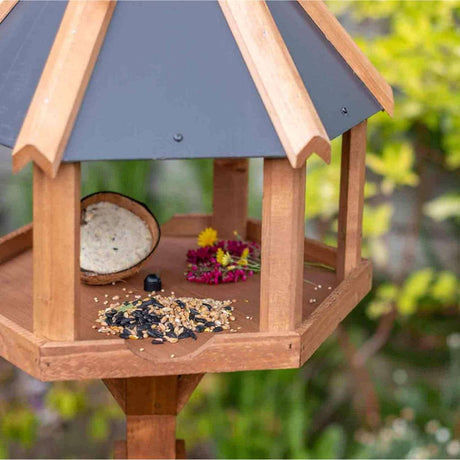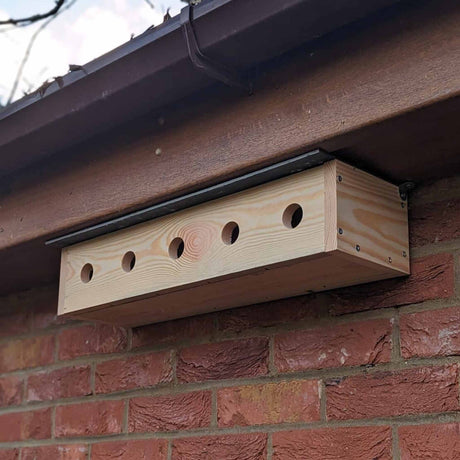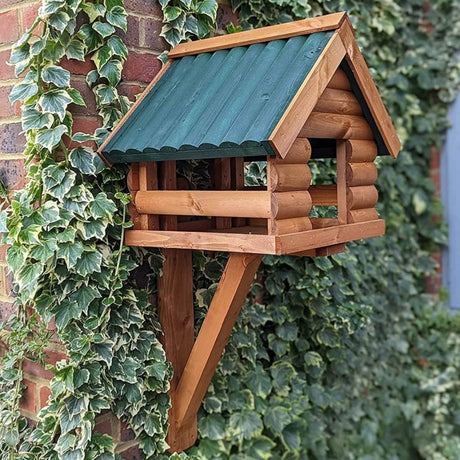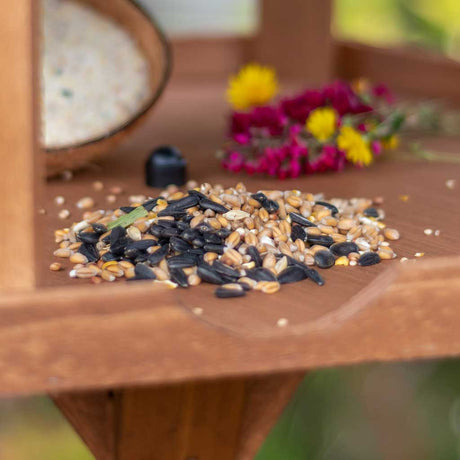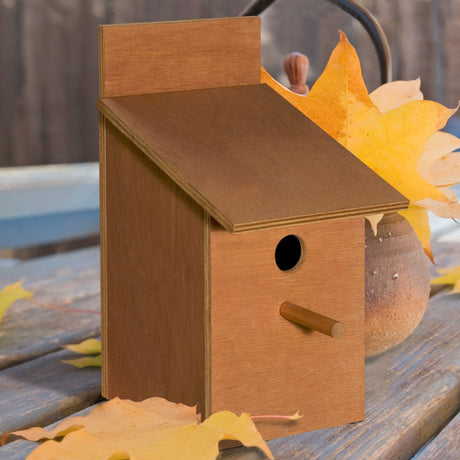Though the plants in your garden might not be putting on much of a show during the winter months, the bird table certainly is. With our year-round residents joined by flocks of cold weather migrants, there is plenty to see. So wrap up warm, grab a hot chocolate, or even a mulled wine, and let's take a look at who's at the bird table in winter.
What Birds Can I See in the Garden In Winter?
A Great Time for Bird Watching.
There are a few reasons why winter is a great time for garden bird spotting.
First, the lack of foliage on the trees and shrubs makes it much easier to see the birds in your garden.
Shorter days mean less time for foraging and scarcity of food in rural areas can bring birds to the table who are too shy to visit during the summer months.
Although a few of our summer birds like swifts and swallows, fly south for the winter, many stay. Also, many species which breed in mainland Europe, the Balkan states or even Russia come to the UK in the winter. This way they escape the much colder weather over there.
The supply of birds in your garden is very much determined by the weather. Mild days may mean there isn't all that much going on. But a cold snap in Europe can send the winter migrants flocking to our shores for a little warmer weather.
And flocking is precisely what many of them do. Birds that are solitary or live in couples over the summer often flock together for warmth during the cold months, Meaning that you may well get a whole host of them to look at.
So there really is lots to see on the winter bird table. Let's take a look at some of the species you might spot.
Robin
Well we had to start with this one, didn't we? The Robin is such a welcome sight in our winter gardens, And we always seem to see more of them in the winter.

This is because there are more of them about. Our UK breeding population is joined in the winter by migrants from Eastern Europe who come here to escape the freezing weather there. We even get some birds of passage, who are just visiting the UK on their way further south.
Wherever the robins in your garden come from they are ground feeders. They favour insects, beetles and worms. All of these are in short supply over winter, they will move on to seeds and berries but will be very grateful for mealworms and suet products too.
The Thrush Family
There are lots of birds in the thrush or Turdus family that can be seen on the winter bird table.
Year-round residents include the Blackbird, Song Thrush and Mistle Thrush, all attractive and regular visitors to the bird table year-round.
The winter visitors are perhaps the star of the show in the thrush family though.
The redwing is a nighttime migrant who comes in from Northern Europe as the weather gets colder. You will spot him by the distinctive red underside of the wings. The call is a distinctive "tweep" which you can hear often at night as they arrive in the UK.
The Fieldfare is another winter migrant that you might be lucky enough to spot at your bird table. These are quite large thrushes and really beautifully marked with a speckled cream brown, grey and black plumage.
All the thrushes are pretty omnivorous - they'll eat whatever they can get their beaks on.
They are naturally ground feeders, so provide for them on the bird table or ground feeding trays. They love kitchen scraps, soaked raisins and suet products.
Thrushes and other ground-feeding birds will favour your garden if you leave some leaf litter lying around through winter. This gives them a natural place to forage.

The Tit Family
I always think of tits (especially blue tits) with their bright colours and cheeky ways, as summer birds. But they are very much around in the winter too.
Blue tits are one of the most common visitors to our gardens and have increased in numbers in the UK since the 1970's probably due to our increased interest in bird feeding.
The winter weather may tempt more reticent tits into your garden. You could see the coal tit or the colourful and sizable great tit.
If you are near the forested areas of Scotland, a distinctive Crested Tit might be tempted to your feeders.
You might also see the lovely little long-tailed tit with its cute round shape and distinctive pastel pink markings. Although this one looks like a tit it's actually a member of a different family of birds.
As we know, tits prefer to eat hanging from a feeder, nuts seeds and suet will all be welcome treats during the winter months.

The Finches
You can also expect to see plenty of finches around in the winter—both our native breeding finches and winter migrants.
All the finches are showy birds and a treat to spot in the winter garden.
Goldfinches are one of our great conservation success stories, and numbers have increased dramatically since a disastrous low in the 1980s. Like the blue tit, this revival is thought to be primarily down to the support they have received from garden feeding.
The chaffinch is a common sight in summer and winter, but no less welcome for that.
Their plumage makes them blend in well with foliage, and they can be difficult to spot under hedges where they prefer to feed. But once the take-off you can quickly identify them from their white undersides and wingtips.
The brambling is a beautiful finch that visits from Europe during the winter. They can be spotted by their white rumps, beautifully marked wings and organogenesis breasts.
The real supermodel of the finch family, though is the Bull Finch. They are year-round residents, usually preferring woodland edges. In winter though they may become less shy and venture to the bird table for a feed. Bull finches have glorious plumage: a black head and stunning pinky-peach underside.

Two to Watch out For
Two birds that are rarely seen in gardens, but may make an appearance in the winter months in some areas are goldcrests and waxings, Spotting either of these at your table is a real treat.
The goldcrest is our smallest bird. The males are easily identifiable by their black head with a yellow/orange central stripe. They are a year-round resident. But in winter their numbers are increased by flocks of migrants from Scandinavia. Though they prefer to breed in mature woodland and coniferous forests, in the cold weather they flock with other small birds and range around looking for food. So you may have a gang of them turn up in the garden. Generally, insect eaters, goldcrests will enjoy chopped mealworms or suet, or a little finely grated cheese.
Waxwings are winter visitors who arrive on the east coast then spread throughout the country in search of suitable food. They love berries. Rowan, cotoneaster and rose hips being favourites. OIn the bird table you could offer some soaked raisins or chopped apple.
It's not really the wings that set the waxwing apart, its the fantastic red/brown Mohican crest on top of the head. Difficult to miss.

Don't Neglect the Regulars.
With all this exotic winter action going on at the bird table, it could be easy to overlook our ubiquitous "little brown jobs". But the sparrows and dunnocks will be there too, and keeping them well fed in winter is really important. Though we think of them as common, these species have been in severe decline since the 1970s. Winter is a challenge for them, and keeping a well-stocked bird table can be a real help.
My personal favourite, the starling also sticks around to entertain us in winter and needs support. I love them for their beautiful plumage and constant chattering. Though there are still plenty of them in gardens, numbers are sliding in rural areas. So it's up to us gardeners to keep them well fed.

Winter Garden Bird Watching - a Real Treat
There is so much birdlife to see in the garden in winter it's a real treat to brighten the dullest days.
And the best bit is that if it's really cold and miserable, you don't even have to leave the house to enjoy the action.
Offering food and water to birds in your garden doesn't just provide you with entertainment, it also provides valuable support to our wildlife.
So keep up the good work and enjoy the show!
We hope you enjoyed this post and found it useful. If you have questions or suggestions, we would love to hear them. Leave us a comment below.


